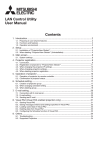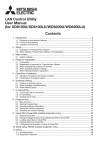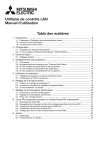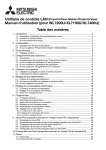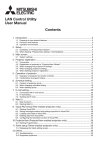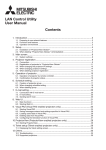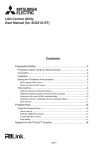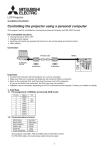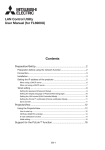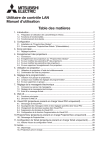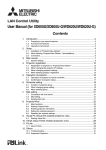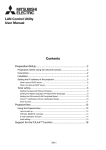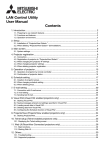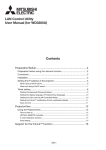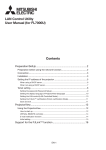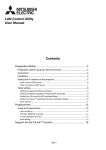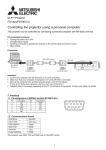Download User Manual Contents
Transcript
LAN Control Utility (ProjectorView Grobal+/ProjectorView) User Manual Contents 1. Introduction............................................................................................................. 2 1.1. Preparing to use network features........................................................................................... 2 1.2. Functions and features............................................................................................................. 2 1.3. Operation environment............................................................................................................. 2 2. Setup....................................................................................................................... 4 2.1. Installation of “ProjectorView Global+”..................................................................................... 4 2.2. When deleting “ProjectorView Global+” (Uninstallation).......................................................... 5 3. Main screen............................................................................................................. 6 3.1. System settings........................................................................................................................ 8 4. Projector registration............................................................................................... 9 4.1. 4.2. 4.3. 4.4. 4.5. Connection................................................................................................................................ 9 Registration of projector to “ProjectorView Global+”............................................................. 10 When changing the projector IP settings............................................................................... 12 When changing projector settings.......................................................................................... 13 When deleting projector registration...................................................................................... 13 5. Operation of projector........................................................................................... 14 5.1. Operation of projector by remote controller........................................................................... 14 5.2. Confirmation of projector status............................................................................................. 15 6. Schedule setting.................................................................................................... 16 6.1. Creation of projector group.................................................................................................... 16 6.2. When changing schedule setting........................................................................................... 17 6.3. When deleting group.............................................................................................................. 18 7. E-mail setting........................................................................................................ 19 7.1. Connection with E-mail server................................................................................................ 19 7.2. E-mail setting.......................................................................................................................... 19 7.3. Sending test E-mail................................................................................................................. 19 8. ProjectorView........................................................................................................ 20 8.1. 8.2. 8.3. 8.4. 8.5. Main functions........................................................................................................................ 20 Starting ProjectorView............................................................................................................ 20 Entering projector information................................................................................................ 23 Setting the network password................................................................................................ 24 Resetting the network settings............................................................................................... 24 9. Visual PA2 (Visual PA2 enabled projectors only)................................................... 25 9.1. 9.2. 9.3. 9.4. 9.5. Starting Visual PA2................................................................................................................. 25 Saving messages entered and settings specified in Visual PA2............................................ 26 Loading saved data in Visual PA2.......................................................................................... 26 Deleting data from Visual PA2................................................................................................ 26 Configuring the Schedule function of Visual PA2................................................................... 27 10.Telnet setup (Telnet enabled projectors only)........................................................ 28 11.Others.................................................................................................................... 29 11.1.Troubleshooting...................................................................................................................... 29 11.2.Supported Projectors............................................................................................................. 29 1. Introduction 1.1. Preparing to use network features This projector is equipped with the network function to control and monitor the projector’s operations and to send e-mail notification. Before using the network function, perform the following three preparation steps. • Installing the ProjectorView Global+ • Assigning the projector IP address • Configuring settings such as PASSWORD, E-mail Setting, Language, and PJLink certification Setting by running Telnet (Telnet enabled projectors only) or using ProjectorView The projector IP address, password, and PJLink certification can be configured on the projector main screen. For more information, see the section describing network settings provided in the projector's User Manual. 1.2. Functions and features ProjectorView Global+ • • • • • • • 200 units of projectors can be remote-controlled at the maximum. Settings such as the IP address of the projector can be configured. You can register multiple projectors in a group and control them collectively. Various conditions of connected projectors can be monitored. Schedule of the power supply ON/OFF can be set every group. Schedule of the power supply ON/OFF can be set every day. When the communication with the projector monitored by the theft detector is disrupted, warning E-mail is issued to the designated address. • Message can be displayed on the screen of the operating projector. (Visual PA2 enabled projectors only) • The projector is capable of reading aloud on-screen messages. (Text Speech enabled projectors only) ProjectorView • Each projector can be controlled separately using a Web browser. • When an error or warning occurs with the projector, warning E-mail is issued to the designated address. PJLink • The product supports the industry standard protocol PJLink for projector control. 1.3. Operation environment • Supported OS Windows XP, Windows Vista and Windows 7 (Operation of the projector isn’t guaranteed in a 64-bit version of any operating system.) • CPU Higher than the minimum specifications for the above operating systems to work • Memory More than the minimum specifications for the above operating systems to work • Free HDD space 32 MB or more (recommended) • Web browser (When using ProjectorView) Internet Explorer Ver. 7.0, Ver. 8.0, and Ver. 9.0 (recommended) (Java Plug-in *1 must be installed and JavaScript must be enabled.) *1 Installing Java Plug-in: (1) Download JRE6 from the JAVA download center on the Oracle Web site (http://java.sun.com/javase/downloads/index.jsp). (When this file URL is not a valid location, search for “JRE6 download” using a search engine and access the download site.) (2)Execute the downloaded file. (3)After installation is complete, disable the cache settings as following procedures. 1. Select [Start] - [Control Panel] - [Java]. 2. Select [General] tab and click [Settings...]. 3. Click [Delete Files...]. 4. Click [OK] in the Delete Temporary Files window. EN-2 1. Introduction Microsoft® and Windows® are the registered trademark or trademark of Microsoft Corporation in the United States and other countries. (The official name of Windows is Microsoft Windows Operating System.) Other company names and product names described in this document are the registered trademark or trademark of the respective holders. Furthermore, “®” mark and “TM” mark are omitted in this document. • Windows XP is referred to as Microsoft Windows XP Home Edition/Professional. • Windows Vista is referred to as Microsoft Windows Vista Home Basic/Home Premium/Business/Enterprise/ Ultimate. • Windows 7 is referred to as Microsoft Windows 7 Home Basic/Home Premium/Professional/Enterprise/ Ultimate. EN-3 2. Setup 2.1. Installation of “ProjectorView Global+” Before starting installation, be sure to read “ReadMe.txt” contained in the CD-ROM. Copy “ProjectorView Global+v3_2.msi” contained in the Tools folder of CD-ROM to the hard disk of your personal computer. (1)Double click “ProjectorView Global+v3_2.msi”, and start up the installer of “ProjectorView Global+”. (2)The setup window is displayed. Click [Next]. (3)Select the folder to be installed, and click [Next]. <Note> • When installing “ProjectorView Global+” to Windows Vista or Windows 7, do not change the installation destination folder. (4)Click [Next]. • Installation is started. EN-4 2. Setup (5)When the installation has been completed, click [Close]. 2.2. When deleting “ProjectorView Global+” (Uninstallation) <Note> • When uninstalling “ProjectorView Global+”, “ProjectorView Global+” should be ended in advance. If the application continues operating, uninstallation can not be performed normally. (1)Double click “ProjectorView Global+v3_2.msi”, and start up the installer of “ProjectorView Global+”. (2)Select “Remove ProjectorView Global+”, and click [Finish]. • The uninstallation is started. (3)When the uninstallation has been completed, click [Close]. • Logs and setting files are not automatically deleted. Delete them manually. EN-5 3. Main screen Menu bar Configuration You can specify the following settings: Add New Group: You can create a new group. Edit Schedule Setting: You can edit schedule settings set for existing groups. Search Projector: Automatically searches available projectors. Assign IP: You can configure IP settings of the projector. Edit Projector Setting: You can edit projector settings. Edit E-mail Setting: You can configure E-mail settings used for this application. Search Projector Setting: You can specify a search range for communication with the projector via a router. System Configuration: You can configure system settings of this application. Help The version information is displayed. Tool bar ProjectorView Telnet Visual PA2 Remote Controller Refresh Status Select All Exit You can control each projector separately using a Web browser. In case of an error in the projector, the details of the error are displayed. For details, see page 20. You can make various settings using Telnet. (Telnet enabled projectors only) You can set the password, ProjectorView display language, LAN control, and PJLink certification. For details, see page 28. You can display a line of any text on the projector screen (Visual PA2 enabled projectors only). For details, see page 25. Remote Controller window can be displayed to operate the projector. You can turn on/off the power, and select the input source. The current status of Power, Input Source, AV Mute, and Lamp Time (Low) of the projectors being displayed in the projector list can be reacquired. The status of Input Source and AV Mute will not be obtained under the following conditions: • when the projector is powered off • during warm-up or cool-down. All projectors currently displayed on the projector list can be set to selected/non selected state. You can exit “ProjectorView Global+”. However, you cannot exit the application during the automatic projector search and the projector status refreshing. Even during the projector status acquisition, you can exit the application forcefully by button at the upper right corner of the main screen. In this case, clicking the Windows warning message is displayed. EN-6 3. Main screen Group Name Group of the projector can be selected. When you select “All”, all the registered projectors are displayed. Newly created group(s) are added to the list. When you select your choice of group, all projectors that belong to the selected group are displayed. Status tag Property and status of the projector can be indicated. When clicking each tag button (except the MAC address), the list can be rearranged (sorted). Projector list display column List of the projector which belongs to the selected group can be displayed. Status of the projector can also be displayed. The display color changes as follows depending on the condition of the projector: Black: In normal condition Red: In abnormal condition ( Check the abnormal condition by ProjectorView. When the communication fails, see “11.1. Troubleshooting.”) Black (yellow background): Warning about the lamp lifetime White (red background): The communication with the projector monitored by the theft detector has been disrupted. ( Check the condition. There is a possibility of theft.) Gray: In communication inoperable condition Error Message Error messages detected in communicating with the projector can be displayed. Operation status display column Operation status of “ProjectorView Global+” can be indicated. Operation status during communication processing by remote-controlling and schedule can be indicated. EN-7 3. Main screen 3.1. System settings (1)Select “System Configuration” from “Configuration” of the menu bar on the main screen. • “System Configuration” window is displayed. (Default settings are shown in the following example.) Item Description Language Refresh Status Cycle You can select the user interface language, Japanese or English. You can set the cycle to obtain the projector status. Select an integer value with no decimal part from 1 to 60 minutes. (2)Change the settings as needed and click [Save]. • To update the settings you changed, it is necessary to restart “ProjectorView Global+”. EN-8 4. Projector registration 4.1. Connection Connect the controller PC and the projector, which have installed “ProjectorView Global+”, to a commercially available LAN cable. When connecting multiple projectors, use a commercially available hub. • A LAN terminal is required for the controller PC. • Use a LAN cable compatible with Category 5 and 100BASE-T. Use a crossover LAN cable in the case of connection example 1 and use a straight-through LAN cable in the case of connection example 2. (In the case of connection example 3, see the instruction manual of the router.) • Do not touch metal parts of the LAN terminal and LAN cable by hands charged of static electricity. Discharge of static electricity may cause a failure of the projector. • Up to 200 units of the projectors can be registered at the maximum. <Note> • The LAN function may be unavailable depending on the standby mode setting of the projector. To enable the LAN function, change the setting referring to the User Manual of your projector. Connection example 1 Controller PC Projector Commercially available LAN cable (Crossover cable) Connection example 2 Projector Controller PC External hub Commercially available LAN cable (Straight-through cable) Connection example 3 Projector Router Projector Controller PC External hub External hub EN-9 4. Projector registration 4.2. Registration of projector to “ProjectorView Global+” The procedures to register projectors vary among the foregoing connection examples. • In connection examples 1 and 2 (where projectors are installed within the same local network), the projectors within such network are automatically detected and registered. For details, see procedure A below. • In connection example 3 (where projectors are installed via a router), specify the range of the projectors’ IP addresses and then carry out automatic projector search within the range to register projectors. For details, see procedure B below. • Up to 200 units of projectors can be registered at the maximum. • Projectors that have just been registered by the automatic projector search aren’t belonging to any group. When the projectors you registered aren’t displayed on the projector list on the main screen, select “All” from the group select pull-down menu. Procedure A - For connection examples 1 and 2 (where projectors are installed within the same local network) (1)Start up “ProjectorView Global+”. (2)Select “Search Projector” from “Configuration” of the menu bar on the main screen. • The projectors connected to LAN are searched automatically. • Some projectors may require you to enter the password when establishing projector connections for the first time. If the projector password is changed, you need to enter that new password. <Note> • Ensure that the IP address of the PC and that of the projector are in the same network group. (The last octet of the IP address should contain a different value.) • Be sure to make a note of the IP addresses you set. If you forget the IP addresses, you may not be able to detect the projectors again. • At initial setup, DHCP or Auto IP (169.254.0.1 through 169.254.255.254) automatically assigns an IP address. Note that a different IP address may be assigned every time you start the projectors. If a connection cannot be established, execute “Search Projector”. • If you change the IP address in the projector menu after the projectors have been detected, execute “Search Projector” again. • It is recommended that you assign an IP address of the projector to the fixed IP address. • If several projectors with the same IP address are registered, delete the ones which are not connected to the network from “Edit Projector Setting”. EN-10 4. Projector registration Procedure B - Connection example 3 (where projectors are installed via a router) To automatically detect projectors connected via a router, confirm the IP address in the projector network menu and specify a range of IP addresses to search that particular IP address using “Search Projector Setting”. <Note> If you want to connect a projector via a router after automatically detecting it, you need to specify a search range of IP addresses that includes the projector's IP address in advance. (1)Start up “ProjectorView Global+”. (2)Select “Search Projector Setting” from “Configuration” of the menu bar. • “Search Projector Setting” window is displayed. Item Description Start IP Address Specify the IP address that is the start of the search range. (You cannot specify an IP address that contains a range other than 1 to 254 for the first and last octets and a range other than 0 to 255 for the second and third octets.) Specify the last octet of the IP address that is the end of the search range. (You cannot specify a value that contains a number other than 1 to 254. In addition, you cannot specify a value that is smaller than the last octet of the search start IP address specified in step .) The settings you made are saved and then the automatic projector search is performed. End IP Address Search Projector (3)Specify the projector search range by IP address ( and ). • Up to 16 search ranges can be set. (Settings can be configured for each line of the search range.) (4)To save the settings, click [Save]. To continue the projector search, click [Search Projector]. • When you click [Save], the search ranges you specify are saved and the “Search Projector Setting” window is closed. • When you don't want to save the search ranges, click [Cancel] to close the “Search Projector Setting” window. • After saving the settings, by selecting “Configuration” on the menu bar and then selecting “Search Projector”, you can perform automatic projector search within the search ranges you saved. • Some projectors may require you to enter the password when establishing projector connections for the first time. Authentication is automatically performed from the second time onwards unless projectors are deleted from the list. EN-11 4. Projector registration <Note> • Set the default gateways of the projectors and PC correctly. For details, contact your network administrator. • Be sure to make a note of the IP addresses and default gateways you set. If you forget the setting values, you may not be able to detect the projectors again. • At initial setup, DHCP or Auto IP (169.254.0.1 through 169.254.255.254) automatically assigns an IP address. Note that a different IP address may be assigned every time you start the projectors. If a connection cannot be established, execute "Search Projector". • If you change the IP address in the projector menu after the projectors have been detected, execute “Search Projector” again. • It is recommended that you assign an IP address of the projector to the fixed IP address. • If several projectors with the same IP address are registered, delete the ones which are not connected to the network from “Edit Projector Setting”. 4.3. When changing the projector IP settings You can change the projector IP settings. (1)Select the projector which you like to change from the projector list on the main screen. (2)Select "Assign IP" from “Configuration” of the menu bar on the main screen. • “Assign IP” window is displayed. (3)To automatically assign an IP address, select [Auto] and then select DHCP. To manually assign an IP address, select [Manual] and enter values for IP Address, Subnet Mask, and Default Gateway. Item Description DHCP IP Address Subnet Mask Default Gateway Obtain an IP address via a DHCP server. Enter an IP address. Enter the subnet mask. Enter the default gateway address. <Note> • An error dialog for theft detection may be displayed after the IP settings have been changed. • If a connection cannot be established after the IP settings have been changed, execute “Search Projector”. • If you want to change the IP address of a projector connected via a router, you need to specify a search range of IP addresses that includes the new IP address in “Search Projector Setting”. • Consult your network administrator about the subnet mask and default gateway in advance. EN-12 4. Projector registration 4.4. When changing projector settings (1)Select the projector which you like to change from the projector list on the main screen. (2)Select “Edit Projector Setting” from “Configuration” of the menu bar. • “Edit Projector Setting” window is displayed. (3)Set the Projector Name and its group and the theft detector. Item Description Projector Name MAC Address IP Address Enter the projector name within 64 characters in one-byte alphanumeric symbol. The MAC address is displayed. The displayed address cannot be changed. The IP address is displayed. The displayed address cannot be changed. When it is required to change the IP address, use [Assign IP]. From the pull-down menu, select the group to which the projector is belonging. (A new group can be created by clicking [Add New Group]. See “6.1. Creation of projector group”.) Turn on or off the theft detector. Group Name Theft Check <Note> In right-click menu also, the setting of the projector can be changed. (Multiple projectors can be selected.) • Add to New Group : Addition to a newly created group • Add to Existing Group : Change of the belonging group • Theft Check Setting : Change of theft detector setting (ON/OFF) 4.5. When deleting projector registration (1)Select the projector which you like to delete from the projector list on the main screen. (2)Select “Edit Projector Setting” from “Configuration” of the menu bar. • “Edit Projector Setting” window is displayed. (3)Click [Delete]. • The selected projector is deleted. EN-13 5. Operation of projector 5.1. Operation of projector by remote controller Group or single unit of projector can be operated. (1)Select the projector which you like to operate from the projector list on the main screen. • When selecting more than one projector simultaneously, select while pressing the Ctrl key. (2)Click [Remote Controller] of the tool bar on the main screen or when you like to operate a certain projector, double click the projector on the projector list on the main screen. • “Remote Controller” window is displayed. (3)Operate the projector by selecting each operating button on the window. Command Button Description Power Power ON Power OFF Turn on the power supply of the projector. Turn off the power supply of the projector. Input Source COMPUTER 1 COMPUTER 2 VIDEO S-VIDEO COMPONENT DIGITAL 1 *1 DIGITAL 2 *1 DIGITAL 3 *1 STORAGE 1 STORAGE 2 NETWORK Change the input signal to COMPUTER 1. Change the input signal to COMPUTER 2. Change the input signal to VIDEO. Change the input signal to S-VIDEO. Change the input signal to COMPONENT. Change the input signal to DIGITAL 1 *1. Change the input signal to DIGITAL 2 *1. Change the input signal to DIGITAL 3 *1. Change the input signal to PC Less Presentation. Change the input signal to USB Display. Change the input signal to LAN Display. Exit Close the Remote Controller window. *1 DIGITAL 1-3 are displayed with HDMI (HDMI 1/HDMI 2), DVI-D or SDI by a connected projector. <Note> • The next operation can not be performed until the previous operation has been completed. • The operation can not be performed during re-obtaining (refreshing) the projector status. • Available input sources vary depending on the type of projectors. You cannot select input sources that aren’t supported by the projector. EN-14 5. Operation of projector 5.2. Confirmation of projector status The status of the projector is displayed on the projector list on the main screen. Item Description Check No. Projector Name MAC Address IP Address Power Input Source *1 Theft detector setting (ON/OFF) Projector list registration number Projector name set in the application MAC address of the projector IP address of the projector Power supply status of the projector (ON/OFF) Input signal of the projector (COMPUTER 1/COMPUTER 2/VIDEO/S-VIDEO/ HDMI (HDMI1/HDMI2)/DVI-D/SDI/PC Less Presentation/USB Display/LAN Display/COMPONENT) Mute status of the projector (ON/OFF) Lamp illuminating time (HHHH:MM) In the case of the projector equipped with two lamps, illuminating time for the lamp 1 is displayed in the left side and illuminating time for the lamp 2 is displayed in the right side. The belonging group of projector AV Mute Lamp 1/2 Time (Low) Group Name *1 HDMI and DVI-D are displayed with DIGITAL 1 or DIGITAL 2 by a connected projector. • The projector status is re-obtained (refreshed) automatically and periodically, but the present status can also be obtained by the user’s instruction. When clicking [Refresh Status] of the tool bar on the main screen, Power, Input Source, AV Mute, and Lamp 1/2 Time (Low) status of each projector is re-obtained. • The status of Input Source and AV Mute will not be obtained under the following conditions: - when the projector is powered off - during warm-up or cool-down. • When clicking the status tag of the projector list (except the MAC address), the list can be rearranged (sorted). The list can be rearranged in reversed order by pressing one more time. • When clicking [Select All] of the tool bar, all projectors in the projector list become selected/non selected state. • If any abnormal state of the projector is detected by acquiring the projector status, an error message will be displayed on the error message display column at the lower part of the screen. <Note> • The default cycle of the automatic re-acquisition is 10 minutes. To change this cycle, see “3.1. System settings.” • When multiple projectors are connected, it may take time to acquire the status. During acquiring the status, the status bar at the lower part of the main screen becomes “Getting status...”, and it becomes “Done” when the acquisition has been completed. EN-15 6. Schedule setting 6.1. Creation of projector group Multiple projectors can be controlled and batched by sorting groups. Also, each group can set each time of the power supply ON/OFF every day. Since the schedule of the power supply ON/OFF is performed by each group, the projector which you like to operate at the same schedule should be integrated into the same group. When Power ON and Power OFF are enabled, their time settings are indicated on the schedule list. [Example] W hen setting the schedule for the group “group 1” to turn the power supply ON at 9:00 on Monday, turning OFF at 17:00 on the same day, ON at 8:30 on Thursday, and OFF at 17:40 on Friday. Group name Day of the week Time of power supply ON Time of power supply OFF When validating the setting, put a check mark in the box. Schedule list Time of power supply ON/OFF (1)Select “Add New Group” from “Configuration” of the menu bar. • “Add New Group” window is displayed. (2)Input the group name to be created in the “Group Name” column (within 16 characters in one-byte alphanumeric symbol). (3)Select the day of the week to be set for the time of the power supply ON/OFF. (4)Only when setting the time of the power supply ON, set the time in the “Power ON” column, and put a check mark in the “Enable” box. (5)Only when setting the time of power supply OFF, set the time in the “Power OFF” column, and put a check mark in the “Enable” box. (6)When there are more than one day of the week to be set for the power supply ON/OFF schedule, repeat the procedure (3) to (5). (7)Click [Add]. EN-16 6. Schedule setting <Note> • The power supply ON and the power supply OFF can not be selected at the same time of the same day of the week. • The Schedule Setting will be executed while “ProjectorView Global+” is in operation. • Depending on usage conditions, such as when there are so many projectors that you need to control, the time to be executed by the power supply control may deviate from the setting time of the schedule. • When utilizing the Network Time Protocol (NTP) function on the Internet, the schedule operation may not be executed because the setting time of the schedule jumps over. • When the automatic time adjustment by summer time is valid, the schedule operation may not be executed because the time is automatically adjusted before and after switching over. 6.2. When changing schedule setting (1)Select a group which you like to change from the Group select pull-down menu on the main screen. (2)Select “Edit Schedule Setting” from “Configuration” of the menu bar. • “Edit Schedule Setting” window is displayed. (3)Change the contents which you like to correct, and click [Save]. • Corrected contents are reflected. EN-17 6. Schedule setting 6.3. When deleting group (1)Select the group which you like to delete from the Group select pull-down menu on the main screen. (2)Select “Edit Schedule Setting” from “Configuration” of the menu bar. • “Edit Schedule Setting” window is displayed. (3)Click [Delete]. • The selected group is deleted. <Note> • When deleting a group, the projector which has belonged to the relevant group will not belong to any group. Set a new group to belong again on “Edit Projector Setting” window. EN-18 7. E-mail setting When the communication with the projector monitored by the theft detector is disrupted, a warning E-mail can be sent to the designated address, enabling to serve for early detection of the projector theft. The E-mail setting can not be set at every projector and every group. The same setting should be set for all projectors. 7.1. Connection with E-mail server Connect the E-mail server to the network to which the controller PC and the projector are connected that “ProjectorView Global+” is operating. 7.2. E-mail setting Designate the address of the E-mail server and the address of the destination to be sent. <Note> • As for the network environment, confirm to the network administrator. (1)Select “Edit E-mail Setting” from “Configuration” of the menu bar on the main screen. • “Edit E-mail Setting” window is displayed. (2)Input the setting item for the network environment, and click [Save]. Item E-mail Server (SMTP) Description nter the IP address of the E-mail server (Example: 192.168.7.230), or E input the server name (Example: mail.example.com). Destination E-mail AddressEnter the destination E-mail address using up to 64 single-byte characters. (Up to 3 places can be designated at the maximum.) 7.3. Sending test E-mail After completing the setting of the each item on the E-mail Setting window, a test E-mail can be sent to confirm whether the E-mail is correctly delivered to the destination. When clicking [Test E-mail] at the upper right on the Email Setting window, the test E-mail is issued. Confirm whether the E-mail is correctly delivered to the destination address. <Note> • The E-mail function will be executed while “ProjectorView Global+” is in operation. • If the test E-mail is not correctly received, confirm the address of the E-mail server and the destination, and the connection status of the network. For details, make an inquiry to the network administrator. • The E-mail may possibly not be delivered depending on the certification function of the E-mail server. For details, make an inquiry to the network administrator. • When the communication with the projector monitored by the theft detector is disrupted, a theft check error dialog is displayed. However, the projector list isn’t updated at the same time because it takes some time to update the list. EN-19 8. ProjectorView ProjectorView is a web-browser based remote control and monitoring tool for network projectors. If you use the projectors listed in page 29, see ProjectorView in “LAN Control Utility” User Manual included with the projector. <Note> • When CRESTRON is selected with the network menu, it becomes the Web control for CRESTRON. 8.1. Main functions • It displays the status of network projectors (such as the name of the projector, lamp temperature, lamp hours, errors and alerts). • It controls network projectors (such as powering on and off network projectors and switching input or lamp modes). • It sends an E-mail notification when an error or warning occurs. 8.2. Starting ProjectorView (1)Select the projector that you want to operate from the list of projectors on the main screen. • Start ProjectorView for one projector at a time. You cannot concurrently use ProjectorView for multiple projectors. (2)Click [ProjectorView] in the tool bar on the main screen. • The Web browser launches automatically. The password entry window is then displayed. <Note> • You can start ProjectorView by manually typing the projector IP address in your web browser’s address bar. • If you are using a proxy server, do not enable proxy settings when accessing the projector IP address. • Up to three ProjectorView units can be used to control a single projector. (3)Enter the password and click [OK]. (The default password is “admin”.) • “ProjectorView” main window is displayed. <Note> • The connection will turn off in five minutes after the password entry window is displayed. You cannot enter the password then. If this happens, restart the ProjectorView. EN-20 8. ProjectorView ProjectorView main window (PROJECTOR INFORMATION) When you click PROJECTOR INFORMATION, the Projector Information window is displayed. To display the information, enter data in the Setup window. Click [PROJECTOR INFORMATION] to display the window on the left. Click [REMOTE CONTROL] to display the main window (REMOTE CONTROL). Click [SETUP] to display the Setup window. (See page 23.) If there is something wrong with the projector, the red warning indicator lights. Details are displayed in the column below by pointing the cursor to the contents of failures. <Note> See your projector User Manual for the information on when you should replace the lamp. <Note> • If lamp mode is set to “STANDARD”, “Lamp time” displayed may be longer than “Operation time”. ProjectorView main window (REMOTE CONTROL) When you click REMOTE CONTROL, the Remote Control window is displayed. You can click the buttons displayed in the window to remotely control the projector. Buttons with red text show the projector’s current status. The status displayed in this window is updated in regular intervals. You can also manually update the status by clicking GET STATUS. Click [REMOTE CONTROL] to display the window on the left. Click [PROJECTOR INFORMATION] to display the main window (PROJECTOR INFORMATION). Click to obtain the status of the projector. The window is updated simultaneously. <Note> It may take time to update the window. These are virtual remote control buttons. For details, see the description of the remote control button/key in User Manual. These buttons are used to control the projector’s power, input source, and lamp mode. The number of input switches that can be displayed vary depending on the type of projector you use. See your projector User Manual for more information. Lamp mode cannot be switched when the projector is muted. EN-21 8. ProjectorView E-mail notification feature When there is something wrong with the projector, an E-mail notification is automatically sent to the designated address to post an alert or error message. To use this feature, enter the SMTP IP address, E-mail address, and E-mail from in the Setup window. (For details, see "8.3. Entering projector information".) Once you have configured the above settings, the E-mail notification feature remains enabled even after your web browser (the ProjectorView window) is closed. An example: Sending an alert message when the lamp change required. ProjectorView Alert: The lamp has reached the maximum usage time. Replace the lamp and reset the lamp counter. Please see the user manual for detailed instructions. Projector name : abc Projector model : XY1234 Serial number : 12345 Installed date : 2008/01/01 Installed location : 10Factory-5F Operation time : 2146 hours, 43 minutes Lamp time : 4000 hours, 0 minutes Last lamp replaced date : 2008/01/01 Last maintenance date : 2008/01/01 “Projector model” varies depending on the type of projectors. EN-22 8. ProjectorView 8.3. Entering projector information (1)Click [SETUP] in the ProjectorView main window (PROJECTOR INFORMATION). • Setup window is displayed. <Note> • Be sure to enter data within five minutes after the Setup window is displayed. Click OK to save changes. The connection will turn off in five minutes after the window is displayed so you need to go back to the main window (PROJECTOR INFORMATION) to access the Setup window. (2)Enter data in each field, set Alert e-mail service to ON or OFF, choose Language between Japanese and English, set PJLink certification setting to ON or OFF, specify Password setting, and choose to [RESET] Network setting reset. <Note> • When you change the Language setting, be sure to restart the ProjectorView for the changes to take effect. The following table explains each item. Item Description Projector name Enter a unique name to identity the projector. Installed date *1 Enter the date when the projector is installed. Installed location *1 Enter the place where the projector is located. SMTP IP address *2Enter the IP address of the SMTP server used for sending e-mails. (e.g.192.168.0.1) 1 E-mail address * Enter the E-mail address to receive alert messages. (e.g. [email protected]) (Up to 64 alphanumerical characters) 1 E-mail from * Enter the sender of alert messages. (e.g. [email protected]) Last lamp replaced date *1 Enter the date when the last change of lamp was made. Last maintenance date *1 Enter the date when the last maintenance was done. Alert e-mail service Choose whether to send alert messages. Language Choose the display language of ProjectorView (Japanese or English). PJLink certification setting Choose whether to set the PJLink certification setting. Password settingClick [PASSWORD] to access the network password setting window. (For details, see “8.4. Setting the network password”.) Network setting resetClick [RESET] to access the network settings reset window. (For details, see “8.5. Resetting the network settings”.) For data entry, use single-byte alphanumerical characters and symbols ( + - / = * _ ! ? . , : ; # $ % & ( ) | < > [ ] { } " ' @ ). *2 For data entry, use single-byte number characters and symbol ( . ). EN-23 8. ProjectorView 8.4. Setting the network password (1)Click [PASSWORD] in the Setup window. • The window appears to enter the current network password. (2)Enter the current network password and click [OK]. (The default is "admin".) • If the password is correct, another window appears to enter a new one. • If the password is wrong, an error message is displayed. When you click [OK], the current network password window reappears. (3)Enter the New network password and Confirm network password, and then click [OK]. • If passwords entered match, the window closes to save the changes. • If passwords entered do not match, an error message is displayed. When you click [OK], the new network password window reappears. 8.5. Resetting the network settings When you reset the network settings, all data and settings specified in 8.3. Entering projector information will be reverted to factory defaults. Each field will go blank, Alert e-mail service will be set to OFF, Language to English, PJLink certification setting to ON, and Password setting to "admin". (1)Click [RESET] in the Setup window. • The window appears to reset the network settings. (2)Click [OK] to revert the network settings to factory defaults. • If you click [CANCEL], the window closes without reset of the network settings. EN-24 9. Visual PA2 (Visual PA2 enabled projectors only) Visual PA2 is a feature to display messages on the projector screen. It can be used for all active Visual PA2 enabled projectors. Additionally, the projector is capable of reading aloud on-screen messages using the Text Speech function. Note that some projectors may not have this function. See your projector User Manual for more information. <Note> • This projector does not support the Text Speech function. Visual PA2 is not available when using the projectors listed in page 29. This feature operates by referencing the information displayed in the projector list. You need to click [Refresh Status] to update the list before using this feature. 9.1. Starting Visual PA2 (1)Click [Visual PA2] in the tool bar on the main screen. • “Visual PA2” window is displayed. Enter text to display messages on the projector screen. Click to exit Visual PA2. Choose the color and font. You can also choose the flash text option. Choose the color and pattern of the frame. Specify the location of messages. Choose between Horizontal and Vertical, and then choose the relative position. Click to stop displaying messages. Click to delete entered text in the Textbox. Click to display messages entered in the Textbox. Click to save messages entered in Textbox. Settings specified for Text, Frame, Location, and Text Speech can also be saved. Click to load saved messages. Select to set Schedule On or Off. When you click Edit, the Visual PA2 Schedule window is displayed. (See page 27.) (2)Specify Text, Frame, Location, and Text Speech, enter text, and then click [Send]. • Alphanumerical characters, space, and symbols including ! “ # $ % & ( ) + , - / : ; < = > ? @ [ ] can be used. (3)Click [Stop] to stop displaying the message on the projector screen. <Note> • If you exit Visual PA2 while the message is being displayed on the projector screen, a communication error may occur, and an error window may appear. If this happens, restart Visual PA2 and click [Stop]. EN-25 9. Visual PA2 (Visual PA2 enabled projectors only) 9.2. Saving messages entered and settings specified in Visual PA2 You can save messages entered in Textbox, as well as settings specified for Text, Frame, Location, and Text Speech. These must be saved before you activate the Schedule function in the Visual PA2 window. (1)Enter text in Textbox, specify settings for Text, Frame, Location, and Text Speech, and then click [Save]. • “Save Data” window is displayed. (2)Enter the Data name in Save Data name and click [Save]. • Up to 20 data can be saved. 9.3. Loading saved data in Visual PA2 (1)Click [Load]. • “Load Data” window is displayed. (2)Select the data you want to load and click [Load]. 9.4. Deleting data from Visual PA2 (1)Click [Load]. • “Load Data” window is displayed. (2)Select the data you want to delete and click [Delete]. EN-26 9. Visual PA2 (Visual PA2 enabled projectors only) 9.5. Configuring the Schedule function of Visual PA2 By using the Visual PA2’s Schedule function, your intended messages can be displayed on the screen at a set time. (1)Click [Edit] in the Schedule area. • "Visual PA2 Schedule" window is displayed. (The window below shows the example when the schedules have been entered in three rows.) Item Description Enable Day Enables the Schedule function for a particular day or period in each row. From the pull-down menu, selects the day or period during which the Schedule function is enabled. (You can select your choice from Sun, Mon, Tue, Wed, Thu, Fri, Sat, Mon-Fri, Mon-Sat, Sat-Sun, and Everyday.) From the pull-down menu, sets the start time in the Schedule function. From the pull-down menu, sets time period during which a message is displayed. From the pull-down menu, selects the message to be displayed on the screen when the Schedule function is enabled. (More than one message should be saved in advance. See “9.2. Saving messages entered and settings specified in Visual PA2” on page 26.) Clears all entries from the selected row. Saves changes and closes the window. Turn-on Time Period Data Name Clear Exit (2)Configure settings ( through ) and check/uncheck the checkboxes for . • Up to ten schedules can be configured, using the four rows in the table. (You can configure a schedule for each row.) • By default, when no schedule is entered, the table has only one row. A new row is automatically added when you enter the items for , , , and in the first row. In this manner, up to ten rows are automatically added to the table. (3)Click [Exit] to close the window. <Note> • Once a schedule has been configured, it is executed automatically even if the Visual PA2 window is not displayed. • If you send messages manually from Visual PA2 when a schedule is being executed, these messages have higher priority over that schedule. In addition, when the settings of a schedule currently being executed are reconfigered, the Visual PA2 window will close automatically. • More than one schedule cannot be configured at the same time on the same day. • The Schedule Setting will be executed while “ProjectorView Global+” is in operation. • Depending on usage conditions, such as when there are so many projectors to control, time lapses may occur between the start time of Visual PA2 and the start time of a schedule. • When Network Time Protocol (NTP) is used to automatically synchronize with an Internet time server, the start time of a pre-configured schedule may not match the clock of the projector, and the schedule may not be executed. • When the automatic time adjustment by summer time is valid, the schedule operation may not be executed because the time is automatically adjusted before and after switching over. EN-27 10.Telnet setup (Telnet enabled projectors only) You can set the password for ProjectorView, a web-based remote control and monitoring tool for network projectors, and the industry standard protocol PJLink based remote projector management tool, the display language on the ProjectorView, the LAN controlled mode, and the PJLink certification mode by running Telnet on the projector screen. Telnet is not available when using other than the projectors listed in page 29. Configure the above settings in ProjectorView in this case. <Note> • By default, Telnet is disabled on Windows Vista or Windows 7. To enable Telnet, go to Control Panel and select [Programs and Features]. In the left column, select [Turn Windows features on or off] and then check the box next to telnet. (1)Select the projector that you want to configure on Telnet from the list of projectors on the main screen. • Run Telnet on one projector at a time. Multiple projectors cannot be set simultaneously. (2)Click [Telnet] in the toolbar on the main screen. • A command prompt starts. • An error message appears if the selected projector is not Telnet enabled. If this happens, configure the projector from ProjectorView. (3) Press the [Enter] key when the above screen appears. <Note> • Press the [Enter] key within five seconds. If not, the connection is terminated and the [Enter] key is not recognized. If this happens, exit the command prompt and start it again. (4) Setup menus appear. For more information on telnet, see the LAN Control Utility manual that comes with the projector. EN-28 11.Others 11.1.Troubleshooting • The projector can not be recognized. The projector may not be recognized automatically due to the setting of fire wall. In such case, the communication of “ProjectorView Global+” should be registered as an exception to the fire wall. For the setting of the fire wall, see the manual of the software that configures the fire wall. • Operation by the remote controller can not be properly performed. The operation may not be performed until the last operation has been completed. In such case, wait for a while and perform the operation again. In addition, confirm whether the network setting such as IP address is correct. • Application becomes “No reply”. Since it may take time for processing of the automatic status acquisition, the application can not be operated during that time, and “No reply” may be displayed. Wait for a while until the processing has been ended. • Application cannot be operated sometimes. The application cannot be operated during the acquisition of the projector status. When the main power of the projector is off or projectors not actually connected are registered, the projector status acquisition may take longer time to complete because it waits until time out. In this case, you can reduce the acquisition time by deleting unnecessary registered projectors. • Projectors cannot be controlled. Projector status isn’t displayed. Restart the application. If the problem persists, “Initialize Network Configuration” on the setup screen or try “7 factory defaults” using a Telnet connection. In that case, you need to make settings of the projector again, because they are reset to the default values. 11.2.Supported Projectors • “Telnet” is available in the following types of projectors. For details, see “LAN Control Utility” User Manual included with the projector. • “Visual PA2” is not available in the following types of projectors. • If you use ProjectorView in the following types of projectors, see “LAN Control Utility” User Manual included with the projector. XD2000U, XD1000U, WD2000, XL550U, XL650U, HL650U, WL639U, XL1550U, XL2550U, WL2650U, HL2750U, MH2850U, FL7000U, WL6700U, XL6600U, XL6500U, FL7000U(BL), FL7000LU, WL6700LU, XL6600LU, XL6500LU, HD8000, FL6900U, XD3200U, WD3300U, XD3500U, XD221U, XD221U-ST XD2000U(K), WD2000(K), XL550U(K), XL650U(K), HL650U(K), WL639U(K), XL1550U(K), XL2550U(K), WL2650U(K), FL7000U(K), WL6700U(K), XL6600U(K), XL6500U(K), XD221U(K) EN-29 Ver.1.0





























